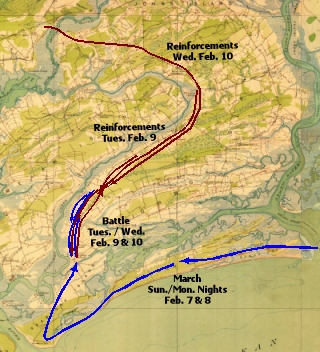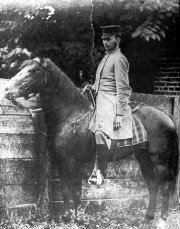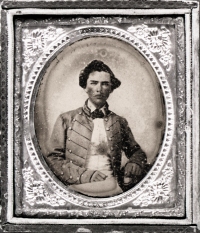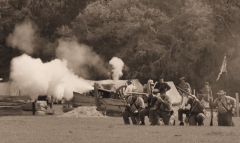Charleston was a major theatre of operations during the Civil War. The fighting in the lowcountry 150 years ago in 1863 and 1864 was especially intense. This series of articles describes some of those actions that took place on Johns Island. The third in the series, this article relates the first of two major battles fought on Johns Island in 1864.

Click to enlarge
The Stage and Actors
Haulover Cut, also known as Haulover Creek, separates Johns Island from Seabrook Island. The Cut, first built in 1715, was an expansion of the existing creek. The Haulover connected Bohicket Creek to the Kiawah River to facilitate trade between Charleston and lower Johns Island, Wadmalaw and Edisto. However, it was not deep enough to accommodate sailing ships so goods had to be unloaded on one side, put on barges (also called lighters or bateaux) and “hauled over” the cut to the other side to be reloaded on another ship.
Most of the Confederate forces stationed on Johns Island throughout the Civil War were small cavalry units recruited from the Sea Islands. The Stono Scouts, led by Captain John Legare Walpole, numbered about 24 men, mostly Johns Islanders. They were stationed on the Island throughout the war until it was abandoned in February 1864. The Cadet Rangers (Co. F, 6th Reg., SC Cavalry), led by Captain Moses Benbow Humphrey, were three dozen former Citadel cadets who left the school, without permission, in June, 1862 to form the Rangers. They served on Johns Island from December 1862 until April 1864. The Rebel Troop (Co. I, 3rd Reg., SC Cavalry), also station on the Island, were mostly from Edisto, Wadmalaw and Johns Islands. These forces were originally commanded by Captain John Jenkins until he was promoted to Major in October 1862. He then commanded all the regular forces stationed on Johns Island for the next two years.

Captain Humphrey
Commander of the Cadet Rangers
Click to enlarge
Union Plans
In early February 1864, Union General Alexander Schimmel £ennig was ordered to attack Johns Island with his troops stationed on Folly Island. The objective was to divert Confederate troops from a larger action that Federal forces were planning in Florida. If all went well, the Union troops might even march all the way up Johns Island, cross the river west of today’s Limehouse Bridge and cut the Charleston Savannah Railroad near Rantowles Creek.
To get to Johns Island, 2,500 union troops were first ferried by steamer across the Stono Inlet from Folly Island to Kiawah on the night of Sunday, February 7, 1864. Once on Kiawah they marched to the Vanderhorst Mansion and camped for the night and most of the following day. Late on Monday, February 8 under the cover of darkness they marched west along Kiawah Island to arrive by 2:00 AM at Captain Sam’s Inlet in time to catch the low tide. In the cold of the night they forded the inlet and continued to march across Seabrook Island to reach the Haulover Bridge before daylight on Tuesday, February 9.
Morning Surprise
The Rebel Troop maintained a sentry post on the Johns Island side of the Haulover in the Gregg house, an imposing three-story brick building, overlooking Haulover Cut (near where the Rosebank Farms stand is located). Under the cover of a heavy fog, the 142nd New York Regiment crossed the bridge surprising the Confederate pickets.
Jumping out the windows, they escaped further up Bohicket Road (now Betsey Kerrison Parkway) to Hickory Hill Plantation over two miles away. There they warned Capt. Humphreys about the large force of advancing Federals. Now joined by the 157th New York Regiment, the Union troops advanced, about a mile from the Haulover to the
entrance of Hopkinson Plantation known as the White Gate.
Heroic Action

Citadel Cadet John Dutart, 20 years old. Killed in opening action
Click to enlarge
Capt. Humphrey gathered his guard force of three dozen Cadet Rangers and the Rebel Troop pickets and returned down Bohicket Rd. to where the Federals had halted. Because of the fog and confusion, Capt. Humphrey did not realize they faced some 400 troops from two regiments. He dismounted his troops and immediately attacked on the right between Bohicket Road and Creek. Former Citadel cadets John S. Dutart and George A. McDowell were killed as they rushed to the attack. Outnumbered ten to one, the Cadet Rangers drove back the tired and confused Union -forces almost to the Haulover Cut where the full force of 2,500 Federal troops had begun to build entrenchments.
Meanwhile, the Confederate forces encamped at Orange Hill Plantation four miles from the Haulover had also been alerted. Major John Jenkins gathered as many troops as he could and headed down to the scene of the action at the White Gate. There he met the now retreating Capt. Humphrey and the remaining Cadet Rangers; others had been taken prisoner. Capt. Humphrey had been hit twice and his marsh tacky Sago had been killed. Private Benjamin Martin came to the Captain’s rescue, helping him onto another horse and off the field. It was still early morning.
Reinforcements Arrive
Realizing he was facing an overwhelming force, Major Jenkins with less than 200 troops determined to hold on as best he could until more Confederates could be rallied from further up Johns Island and from Church Flats on the mainland near today’s Stono Ferry. He retreated slowly back up Bohicket Road past River Road to Fripp’s Plantation where more Confederate troops had arrived including a battery of the Marion Artillery. By 3:00 PM the Federal forces had had enough and were held at this line. They began to move back to a defensive earthwork at the White Gate.
Major Jenkins, with reinforcements continuing to arrive, advanced behind the retreating Union forces over the ground so hotly contested that morning. Reaching Hopkinson’s Plantation near 7:00 PM in the evening the Confederates began to take fire from the entrenched enemy. Major Jenkins was unsure of how many Union troops he faced. He was also concerned about being flanked by forces that might advance up through Rosebank Plantation and Mullet Hall on his left. The Confederate forces moved back for the night to the line they had successfully held at Fripp’s Plantation, some three miles from the Haulover and about a mile from the Federal lines. This was just north east of the area known then as the Cocked Hat, at the intersection of today’s River Road, Bohicket Road and Betsey Kerrison Parkway.
Overnight more Confederate forces continued to arrive including troops from the 26th Virginia Regiment as well as the Inglis Light Artillery and another section of the Marion Artillery. Brigadier General Henry A. Wise arrived the next morning to take command. Wednesday, February 10 saw the battle continue with the lines now entrenched. Federal advances were beaten back by the Confederate artillery and entrenched troops. The Confederate forces were growing but still outnumbered and could not advance. A heavy artillery duel continued through the day. By the afternoon the Confederate forces had grown enough to attempt an attack but they were running low on ammunition. More regiments including some from Georgia were also on the move toward Johns Island.
A Quiet Victory
Early on the morning of the 11th, the Confederate forces advanced only to find the Federals gone. Overnight they had slipped away and, reversing their course, marched over Seabrook Island and reforded Captain Sam’s Inlet in the cold. The Union command had decided they had accomplished their objective of diverting Confederate forces from the Florida. However, by way of the Charleston Savannah Railroad and some determined marching, the Virginia and Georgia regiments were still able to make it to Florida to also defeat the Federal attack there.
The Battle of Haulover was small compared to many others fought during the Civil War. Yet the initiative, determination and courage shown by the Cadet Rangers, Captain Humphreys and Major Jenkins on the first day of the Battle compares very favorably to many more famous encounters.

 A Conversation About Civil Rights
A Conversation About Civil Rights

Thank you for sharing this article. I was not familiar with this battle and always want to learn more about what has happen historically in Gullah- Geechie areas. http://www.plantationquilts.com